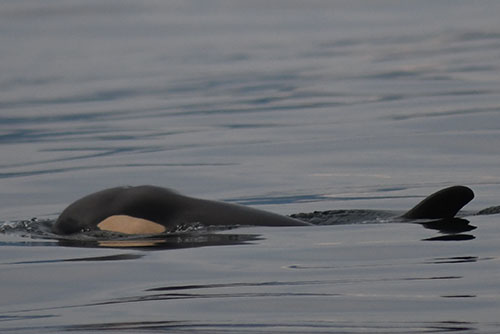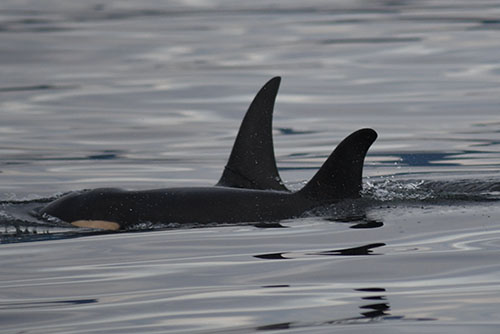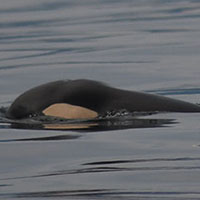— from Center for Whale Research —

J52 showing the characteristic “peanut head” depression behind the outline shape of the skull covered by a thin blubber layer. Note eye in front of eyepatch. Photo by Ken Balcomb, Center for Whale Research
As of 19 September, another Southern Resident Killer Whale, J52 – a two and a half year old male born during the so-called Baby Boom of 2015/2016 is deceased, presumably from malnutrition. His obligatory nursing ended more than a year ago, and his life was dependent upon salmon that have become in short supply this summer.
He was last seen alive near the west entrance of the Strait of Juan de Fuca on 15 September 2017, and photographs taken at the time reveal severe “peanut-head” syndrome associated with impending death. Young J52 was accompanied by his mother (seventeen and a half year old, J36) and an adult male (twenty-six year old L85, potentially his father) at least five miles away from the other members of J and L pods that were foraging within a mile or two of the coastline from Camper Creek to Bonilla Point west of Port Renfrew, British Columbia.

J52 Photo by Ken Balcomb, Center for Whale Research
The observation of this sad event was at sunset, and the young whale appeared very lethargic while barely surfacing as the two adults were swimming around in circles and not feeding while attentive to the young whale. We estimated J52 was within hours, if not minutes, of death at the time, and he was not present during the J pod foray into Puget Sound on 19 September, though his mother and L85 were.
The mother did not appear overly emaciated on either occasion, but she is lean and seems distressed. Yes, these animals do exhibit emotion, and death of an offspring brings it on. It is worthy of note that all of the SRKW observed this summer appear skinny and small compared to Bigg’s Transient killer whales in the Salish Sea that have abundant prey resources (seals and other marine mammals). Timing of food availability is everything, especially in critical phases of growth or gestation.
[perfectpullquote align=”right” cite=”” link=”” color=”#810912″ class=”” size=””]Timing of food availability is everything[/perfectpullquote]
With the passing of J52, three of the six whales born in J pod during the so-called Baby Boom, which began in December 2014 with the birth of J50, have now died; and, two mothers (J14, J28) and a great-grandmother (J2) in the pod have also died. No southern resident killer whales from any of the pods have been born alive and survived thus far in 2017 – the baby boom is over. This population cannot survive without food year-round – individuals metabolize their toxic blubber and body fats when they do not get enough to eat to sustain their bodies and their babies. Your diet doctor can advise you about that.
[perfectpullquote align=”right” cite=”” link=”” color=”#810912″ class=”” size=””]Eighty percent of their known diet consists of Chinook salmon[/perfectpullquote]
All indications (population number, foraging spread, days of occurrence in the Salish Sea, body condition, and live birth rate/neonate survival) are pointing toward a predator population that is prey limited and non-viable. We know that the SRKW population-sustaining prey species is Chinook salmon, but resource managers hope that they find something else to eat for survival, at least beyond their bureaucratic tenure. Our government systems steeped in short-term competing financial motives are processing these whales and the salmon on which they depend to extinction.
If something isn’t done to enhance the SRKW prey availability almost immediately (it takes a few years for a Chinook salmon to mature and reproduce, and it takes about twelve years for a female SRKW to mature and reproduce), extinction of this charismatic resident population of killer whales is inevitable in the calculable future.
Most PVA’s (population viability analyses) show functional extinction as a result of no viable reproduction within decades to a century with current predator/prey trajectories, but it can happen more quickly than that.
[perfectpullquote align=”right” cite=”” link=”” color=”#810912″ class=”” size=””]If something isn’t done, extinction of this charismatic resident population of killer whales is inevitable.[/perfectpullquote]
Facts about SRKW:
Southern resident killer whale females become sexually mature shortly before or during their early teens, and they typically have their first viable offspring in their mid-teens following a gestation of approximately 17 months. The newborn offspring, called calves, are typically about 7-8 feet long and weigh about 400 pounds. They depend on mother’s milk for much of their first year and begin eating solid food (pieces of salmon provided by mother and others) after six to nine months. Young whales of both sexes in this population remain with their mother for their lifetime.
Mother’s lifetime averages slightly more than fifty years, but she typically becomes reproductively senescent in her early forties. On average, she can produce five calves in her lifetime, and some females have a post-reproductive lifetime of up to fifty more years during which time they baby-sit and lead their families to feeding areas that they have learned about in their lifetime.
The males in this population begin to mature in their mid-teens but generally do not father calves until their late teens; and, they are most productive of fathering by their mid-twenties. Older males father a disproportionately high number of offspring and mate with a variety of females within the SRKW population.
Some females have calves by a ‘favorite’ mate, and others spread the gene pool out more.
The adults in this population grow to about 18-23 feet in length (males larger than females), and weigh four to six tons. Eighty percent of their known diet consists of Chinook salmon, a large and nutritious migratory fish that used to be in great abundance, but is currently Endangered throughout most of its range. The southern resident killer whales are also Endangered, due to diminishing food supplies.
For more information on the Southern Resident killer whales, please refer to our website www.whaleresearch.com, or Email: info@whaleresearch.com.
**If you are reading theOrcasonian for free, thank your fellow islanders. If you would like to support theOrcasonian CLICK HERE to set your modestly-priced, voluntary subscription. Otherwise, no worries; we’re happy to share with you.**









This is heartbreaking to read. Thank you for bringing attention to this grave situation; your article is informative and caring. These whales are starving and experiencing so many stressors from all sides.
Is there anything we humans can do for them? If so, we need to be doing it.
What are we willing to do to protect our whales from extinction? There are so many stressors to their habitat and patterns of feeding. Let’s not continue pursuing these poor creatures as aggressively as our tourist economy seems to justify. The Salish Sea, their habitat, is struggling. Salmon are struggling. Where is our compassion?
I Second Sadie and Gretchen’s Comments!
What a Heartbreak and we were so thrilled when they were born! Evidently, Humanity is STILL asleep! Spirit Eagle
This seems like a very good reason to ‘crank up’ to full capacity ASAP… all of the salmon hatcheries in Washington! Since that would be the fastest way possible to put as many fish out in the waters…yes they are not ‘wild’ but they are food and that may just buy some time for the Orca Whales and give the humans that care about this topic more of a chance to make changes that would help! I am not a fisheries biologist nor a politician but it sure makes sense to me… as opposed to arguing if the salmon hatcheries (not talking about Atlantic net pens/farms, I mean hatcheries like Glenwood Springs!) should be running/funded or not!!!
Andrew Stephens point about making any and all salmon available ASAP makes perfect sense to me too.
Question: Can the San Juan’s open a Chinook Salmon hatchery specifically for release to local waters to enhance the food supply until the “upstream” problems can be resolved?
A moratorium on all Chinook salmon fishing for several years might allow the orcas to find enough to eat. It would be well worth the amount paid to fisherman to forgo fishing.
Yeah let’s stop eating their damn salmon….how hard can that possibly be….so sad!